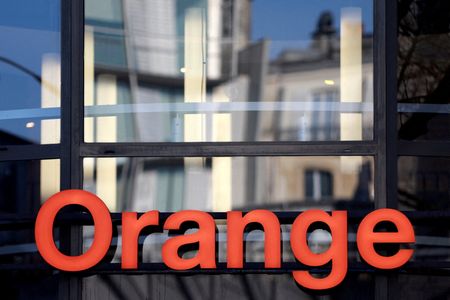By Gianluca Lo Nostro and Tim Hepher
(Reuters) -French jet engine maker Safran gave a weaker than expected outlook for the next four years on Thursday, sending shares 6% lower as it shifts towards more normal growth after a strong post-pandemic recovery in air travel.
Safran, which co-produces engines for Boeing and Airbus narrowbody planes through its CFM venture with GE Aerospace, forecast average annual revenue growth in high single-digits and sharply higher profit by 2028.
It forecast traffic growth, defence budgets and the ramp-up of CFM’s latest LEAP engine would flourish following the industry-wide shock of the pandemic, which crippled air travel.
“We have seen very strong growth since 2021; remember that between 2019 and 2021 our sales fell 40%,” CEO Olivier Andries told reporters ahead of an investor day.
“During this period 2021 to 2025, we have been in catch-up and now we are on a more normalised growth trajectory,” he said.
Safran predicted recurring operating income between 6 billion and 6.5 billion euros ($6.32-$6.85 billion) by 2028 led by its core propulsion business.
It confirmed current-year targets, and forecast 2025 revenue growth around 10% and core profit of 4.7 billion to 4.8 billion euros, based on 15% to 20% higher LEAP deliveries.
Shares in the company fell back 6% from record highs following a 33% run-up in the past year.
The four-year forecast coincides with a crucial period during which CFM aims to start recouping investment in its new generation of LEAP engines by seeing them start to enter the repair shops where engine makers make most of their profit.
Andries pledged to ensure that the shift in focus from the CFM56, the world’s most-sold jet engine, would go smoothly.
In the near term, plane shortages have extended the life of older CFM56 engines, which is an extra boon for maintenance profits.
‘SILVER LINING’
CFO Pascal Bantegnie told investors Safran was planning to keep engine profit margins above 20% rather than dipping lower as some had feared during the model switchover, but several analysts said the forecasts were disappointing.
“Safran management is known for guiding conservatively, though 2028 financial targets disclosed this morning surpassed Safran’s historical levels of caution,” Barclays analyst Milene Kerner said in a note.
A new 5-billion-euro share buyback provided a “silver lining,” Jefferies analyst Chloe Lemarie said.
Bantegnie conceded the forecasts had disappointed some analysts but did not rule out exceeding them, depending on how a raft of assumptions played out in coming years.
The aerospace sector is in a period of flux marked by weak supply chains, labour shortages and volatile exchange rates.
It is also laying groundwork for a new generation of cleaner jets including the RISE technology demonstrator being tested by CFM.
Andries said he expected supply chains to remain fragile in 2025 and even into 2026, but pledged that Safran would work to create a resilient supply chain especially for scarce forgings.
The company, best known for its civil and military jet engines and key role in Ariane rockets, also aims to accelerate growth in defence and space equipment like optical systems.
Safran’s targets do not include the acquisition of Collins Aerospace flight controls, expected to be completed in mid-2025.
Safran plans incremental acquisitions for its main business and will keep selling non-core assets of the former Zodiac, Andries said.
Safran bought the French firm in 2017 amid an industrial crisis at the seats and equipment maker and later earmarked 30% of the assets as non-core, a third of which it has already sold.
Safran said it had turned the corner on the seats business following chronic disruption and set out its benefits and prospects for higher pricing.
One part of the plane inherited from Zodiac is not for sale: Andries said safety systems like escape slides and oxygen supply were Safran’s “hidden gem”.
($1 = 0.9491 euros)
(Reporting by Gianluca Lo Nostro in Gdansk and Tim Hepher in Paris.
Editing by Milla Nissi and Mark Potter)










